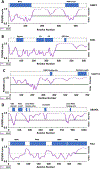Molecular mechanisms of stress granule assembly and disassembly
- PMID: 33007331
- PMCID: PMC7769147
- DOI: 10.1016/j.bbamcr.2020.118876
Molecular mechanisms of stress granule assembly and disassembly
Abstract
Stress granules (SGs) are membrane-less ribonucleoprotein (RNP)-based cellular compartments that form in the cytoplasm of a cell upon exposure to various environmental stressors. SGs contain a large set of proteins, as well as mRNAs that have been stalled in translation as a result of stress-induced polysome disassembly. Despite the fact that SGs have been extensively studied for many years, their function is still not clear. They presumably help the cell to cope with the encountered stress, and facilitate the recovery process after stress removal upon which SGs disassemble. Aberrant formation of SGs and impaired SG disassembly majorly contribute to various pathological phenomena in cancer, viral infections, and neurodegeneration. The assembly of SGs is largely driven by liquid-liquid phase separation (LLPS), however, the molecular mechanisms behind that are not fully understood. Recent studies have proposed a novel mechanism for SG formation that involves the interplay of a large interaction network of mRNAs and proteins. Here, we review this novel concept of SG assembly, and discuss the current insights into SG disassembly.
Keywords: Liquid-liquid phase transition; Protein synthesis; RNA granules; Stress granules; Stress response.
Copyright © 2020 Elsevier B.V. All rights reserved.
Conflict of interest statement
Declaration of interests
The authors declare that they have no known competing financial interests or personal relationships that could have appeared to influence the work reported in this paper.
Figures






References
Publication types
MeSH terms
Substances
Grants and funding
LinkOut - more resources
Full Text Sources
Other Literature Sources

